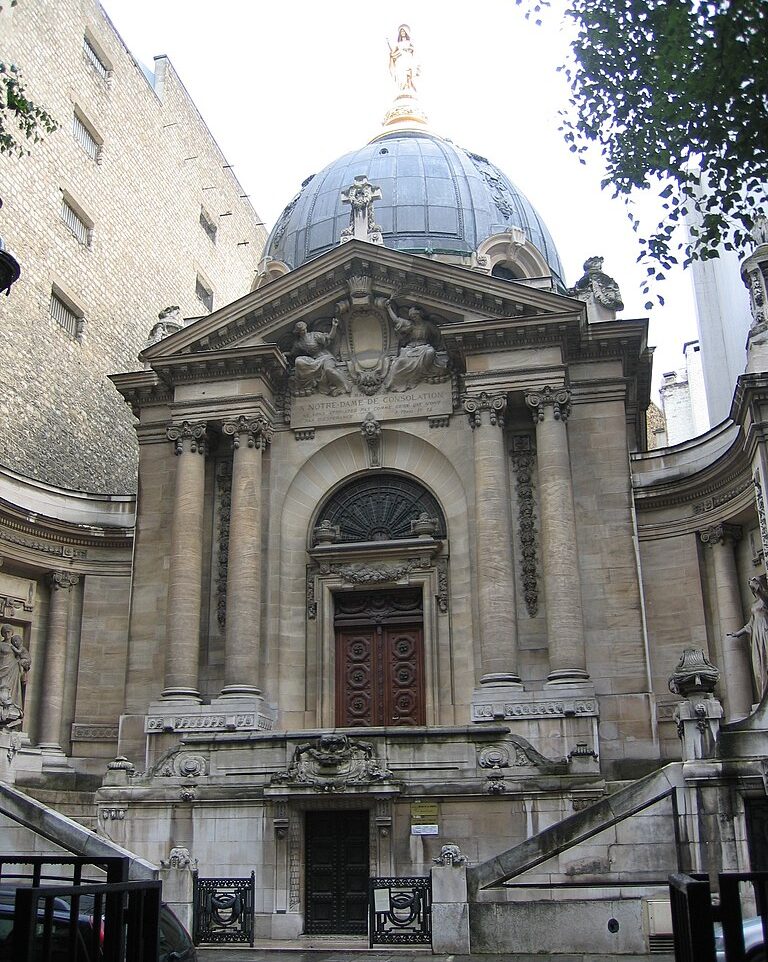The Bazar de la Charité: The Tragic True Story Behind the TV Series


- SUBSCRIBE
- ALREADY SUBSCRIBED?
BECOME A BONJOUR PARIS MEMBER
Gain full access to our collection of over 5,000 articles and bring the City of Light into your life. Just 60 USD per year.
Find out why you should become a member here.
Sign in
Fill in your credentials below.
The devastating fire that killed 126 people at a charity event in the late 19th century is considered one of the worst catastrophes in Paris history. Over the years this tragedy has been depicted in popular culture, such as the Netflix series “The Bonfire of Destiny”
In the afternoon of May 4th, 1897 the annual Bazar de la Charité was in full swing. The temporary pavilion housing the bazaar was packed with mostly women and children, and the great attraction of the event was the new invention of the Lumière Brothers, the cinematograph showing moving pictures. No one who was there that day could have imagined the terrible tragedy which was about to unfold.

Institut Lumière – Cinematograph. By Victorgrigas / Wikimedia Commons
The annual fundraising event was a highlight of the social calendar for Paris’s Catholic elite. It was quite recent – the first had been held in 1885 – but it attracted large crowds of upper middle class and aristocratic ladies. Since these women didn’t work, they directed their efforts towards charity and donated homewares, jewelry, art, and furnishings to be auctioned at the bazaar, as well as staffing the stalls and visiting with their maids and children. In 1897 added glamour was provided by the star visitor, the Duchesse d’Alençon, sister of the Empress of Austria.

Sophie de Wittelsbach, duchess in Bavaria and, by her marriage, Duchess of Alençon, was born on 23 February 1847 in Munich (Bavaria) and died in a fire at the Bazaar of Charity in Paris in the 8th arrondissement on 4 May 1897. From Wikimedia Commons
The bazaar was housed in a temporary wooden structure on an empty lot in Rue Jean Goujon in the 8th arrondissement. The building was themed to represent “Old Paris” with the stalls designed to look like medieval streets, but flimsily built of cardboard and papier-maché with shelter from the weather provided by a painted canvas “roof.” Ominously, a large helium balloon floated in the center.
May 4th was the second day of the bazaar and when it opened at 3 p.m., between 1200-1800 people streamed in. Many queued to watch the amazing new moving picture show and crammed into the small cinema. The projectionist was working in a tiny space – he had already complained it was too small – and barely had room to work his hand-cranked projector, surrounded by oxygen tubes and cans of ether to light the lamps. He was separated from the audience by a mere tar-covered curtain.

Interior of the Bazar de la Charité before the fire. Unknown author. Wikimedia commons
At 4 p.m. he was in the middle of his picture show when the lights went out. He asked his assistant for a new can of ether but instead of drawing aside the curtain, which would expose the audience to a bright light when the lamp was relit, he kept it closed. He then struck a match to illuminate the space while he replaced the can.
The tiny unventilated space was full of ether vapors which instantly caught alight. Within seconds the projection room was ablaze but it still took a minute or two for the audience to realize what was happening. But it was already too late. The fire ripped through the cinema and into the main hall. As the flames licked upwards, the canvas roof caught fire and crashed down, scattering flaming scraps of fabric over people. Then the helium balloon exploded, creating a massive fireball. The stalls had no chance against such an inferno and collapsed in more flames. Paint and the hair lotions worn by the women added extra flammable ingredients. The whole building was engulfed in flames in a matter of minutes.
A reporter from Le Figaro who was covering the bazaar wrote, “As the flames commenced to shoot up and round the Charity Bazaar frenzied women, for the most part in light costumes, escaped from the furnace, uttering cries of ‘Fire!’ The faces of several of them were covered with blood. From time to time a little girl ran out crying for her mother. A number of women of the poorer classes standing in the crowd, at the risk of burning themselves, tore the burning clothing in pieces from the persons of the ladies as they dashed in terror into the street.”

Cover page of Petit Journal, supplément illustré, 16 May 1897, number 339, Incendie du Bazar de la Charité, le sinistre. Wikimedia Commons
Absolute panic broke out. The entrance from the street consisted of two revolving doors; such was the stampede that they quickly became blocked with people fighting to get out and people fell on top of one another, dying of crush injuries as much as burning. Inside, women were hindered by their long dresses which quickly turned the wearers into fireballs themselves once they caught alight. It took the fire brigade just minutes to arrive but already the building had more or less collapsed and the firefighters concentrated their efforts on spraying the neighboring buildings to cool them down.
Despite the terror and panic there were acts of heroism. The rear of the pavilion faced a courtyard and the kitchen of a restaurant next door, whose only access to the yard was by a barred window. Kitchen workers tore away the grille and pulled people through the window to safety, yanking them by their hair if necessary, and even breaking fingers to get them through the small opening. But they managed to rescue 150 women.
Two priests from the convent next door, Fathers Bailly and Ambroise, between them saved about 30 women. A coachman from the Rothschild stables across the street took an iron shaft, usually used to hitch horses to the carriage, and used it as a battering ram to break a small hole in a wall. He then climbed in and passed women out through the hole one by one.
Another heroine was Jeanne de Kergorlay, Vicomtesse de Poilloue de Saint-Perier. She was a tall woman and stayed in the courtyard to give others a leg-up through the kitchen window before perishing herself.

Fire at the Bazar de la Charité, Excerpt from the Petit Journal, illustrated supplement of May 16, 1897. Wikimedia Commons
By 5:30 p.m. it was all over. Nothing remained of the pavilion: it was just a pile of burning ash with the odd piece of smoldering wood. But spread all around was the human tragedy: heaps of bodies burnt beyond recognition. 126 people perished; it was the worst fire in terms of human cost that Paris had ever seen. The bodies were removed to a makeshift mortuary on the future site of the Grand and Petit Palais and so began the gruesome task of identifying the victims. They were overwhelmingly women and children. So many of them were so badly burnt that they could only be identified by jewelry or scraps of clothing that remained attached to the body.
Such was the case with Blanche Grossier, wife of a leading industrialist who was visiting the bazaar and identified by her clothing. Or Jeanne de Kergorlay who was identified by her jewelry. Dental history was made: for the first time teeth were forensically examined in order to identify someone – in this case the gold fillings of the Duchesse d’Alençon who did not survive. Many of those who did survive were horribly burned and disfigured for life – a crushing blow for these society ladies who were forced to retreat into seclusion to hide their scars.

Bazar de la Charité. Les cadavres retirés des décombres. Le Petit Journal. Supplément illustré, 16 mai 1897 from Wikimedia Commons
Immediately, the inquiry began into the causes of the fire and who was to blame. The popular press made much of the fact that only seven men died, and printed hysterical stories of how men had abandoned the women and trampled over them in a selfish pursuit of escape – and these were supposed to be the cream of polite society! In actual fact, so few men died because so few men were there: the Bazar was almost exclusively a female event. Magazine covers and journals sported lurid illustrations of the tragedy and picked over the most gruesome details – quite likely made-up since any surviving witnesses were probably too traumatized to give a coherent account.
In the end it was the organizer, Henry Blount, who was blamed for the tragedy. But although he should bear some responsibility, with hindsight it is obvious that the whole design of the pavilion was lacking the kind of safety measures we now take for granted. Having only two exits, for example, and both at the front. To make matters worse, fake “doors” had been painted on the furthest wall, misleading people into believing there was another exit at the other end. And whatever made the projectionist light a match when he was surrounded by inflammable ether? Even with a 19th century understanding of fire hazards, that seems irresponsible. If one good thing emerged from the fire it was that, for the first time, clearly marked fire exits became mandatory in new buildings.

Père Lachaise cemetery. Monument erected to the unidentified victims of the May 4th, 1897 fire of the Bazar de la Charité. Credit: Asterix93/ Wikimedia Commons
We cannot imagine the psychological trauma the survivors must have carried for the rest of their lives, in an era when psychology and psychiatric therapies were in their infancy and post-traumatic stress disorder was completely unknown. To add to the psychological damage the disaster was “swept under the carpet” and not mentioned in polite society afterwards. This partly explains why it disappeared to some extent from the collective history of Paris; to this day people are discovering, through genealogical research, that they are descended from victims and survivors of the fire.

Chapelle Notre-Dame de Consolation, mémorial du Bazar de la Charité. Photo credit: Marc Baronnet/ Wikimedia Commons
After the site had been cleared, a national subscription was launched and a church was erected as a memorial. Known as Notre Dame de la Consolation it is a mournful church set back from the street on Rue Jean Goujon and easily passed by. It consists of a round nave without transepts, with marble columns and a richly decorated ceiling. Off to one side is the Memorial to the fire – a marble wall bearing the names of those who died, led by the Duchesse d’Alençon herself. This is closed to the public but once a month guided tours are given, explaining the disaster and filling in details of many of the women behind the names.
In 2019 the fire was given a new prominence in a Netflix series The Bonfire of Destiny. Although it is only loosely based on the real events, the first episode gives a dramatic impression of the fire itself and is worth watching for those scenes alone. Along with the flood of 1910, the fire at the Bazar de la Charité is remembered by Parisians as one of the worst catastrophes in the city’s history.
Lead photo credit : After the fire at the Bazar de la Charité. Livre d'or des martys de la charité. Hommage aux Victimes de la Catastrophe du 4 mai 1897", Paris, 1897. Unknown author. Wikimedia Commons
More in bazar de la charité, Duchesse d’Alençon, history in Paris, lumiére brothers




REPLY
REPLY